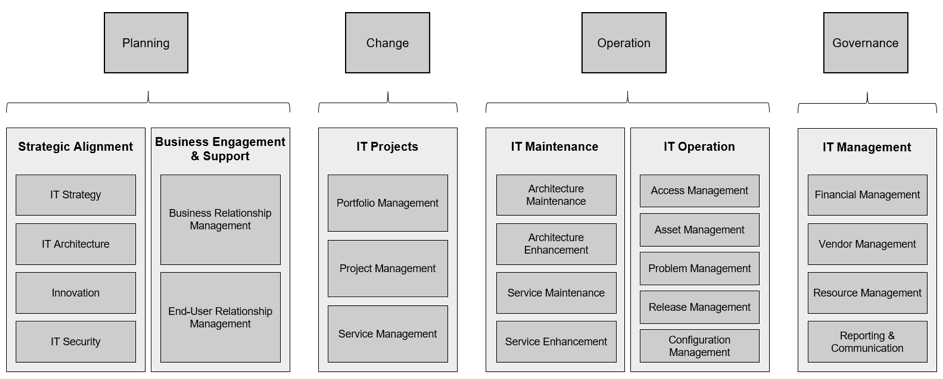Future IT department - will it even exist?
We believe that it is just a matter of time until the expertise and capabilities typically held within “traditional†IT departments are fully integrated into the various business functions, leaving IT departments significantly slimmer both in terms of scope and staff in the future. The IT department as we used to know it is probably soon nothing but a memory. Here’s why…
Traditional IT departments
IT departments have traditionally been the sole proprietor of technology within organizations with responsibility to ensure all technological aspects of an organization are running smoothly. In order to deliver on such responsibility, IT departments have typically been organized and staffed in accordance with the below framework, which can be seen as framework describing a traditional IT department. Evolving technology changes the landscape
Evolving technology changes the landscape
However, as technology is evolving, we have seen a shift towards the utilization of cloud-based IT and Software as a Service (SaaS) within many organizations. As a result, the traditional off-the-shelf and inhouse developed systems are replaced with solutions where the service providers manage much of what is considered traditional IT functions. Thus, utilizing cloud-based services doesn’t require nearly as much personnel to maintain or enhance applications and infrastructure for organizations. This suggests that IT departments no longer need neither the capacity nor the ability to offer such functions to its business to the same extent as before.
Evolving technology has also made essentially all parts of the business reliant on technology and IT and today it is a given that technology and IT is core business for more or less any organization trying to survive in the digital age. With IT being at the core of the business, it does not make sense to have the IT department separated from the business departments anymore, as many of the capabilities needed for the future are a combination of traditional IT capabilities and business capabilities.
To respond to these changes, numerous organizations have undergone transformations lately aiming at bringing IT departments and business departments closer together. As a result, we have seen, and will continue to see, a reduction and blurring of the scope of IT departments. So, what does this suggest for the future? That the IT department will be completely eliminated as this development continues? Spontaneously, many people would probably respond no to that question. But if we think about it a bit more, and look at each of the main functions of a traditional IT department one by one, is it really such an “out there†idea?
IT strategy as part of the business strategy
If we turn to the functions related to strategic alignment first, such functions will probably not have to reside within an IT department going forward. With IT being a part of the core business, an IT strategy separated from the business strategy is redundant. IT should be a key component of the main business strategy instead.
Moreover, innovation has traditionally been driven by the IT department but with the traditional spilt of the IT department and the business side, a lack of understanding of commercial opportunities and challenges have often made IT unable to successfully drive the innovation agenda in the right direction and at desired pace. Instead, such innovation must come for the business side itself, thus placing increasing demands on the business side to significantly enhance their digital and IT competence.
Another strategic shift we have seen is related to IT security where the responsibility has developed quite a bit in recent years. From being more or less just maintenance of anti-virus software to including data and information security in a much broader sense. Data and information security are becoming an increasingly important factor for organizations to consider, but it is not specifically an IT issue anymore, it is an issue concerning the entire organization that relates just as much to ways-of-working as it does to IT.
The only function being difficult to eliminate in this area would be the IT Architecture as it is critical to ensure unified architectural principles encompass the entire organization to allow for efficient collaboration and flexibility across business units.
Are there any pure IT projects?
If we address the functions related to IT projects and Business engagement, such functions are, thanks to the bridging of IT departments and business departments, also becoming more and more uncalled for. Take IT projects for example, is there really a need for an IT project when IT is a key component of the business model and thus an integrated part of any project that the organization run? We believe the need is next to none, IT projects and business projects are the same and hence an IT department won’t need an IT project function. Such capacity can be managed through the business project portfolio instead. The projects we still see needed as pure IT-projects in the future are such projects which are solely linked to an IT function, not resulting in any direct business value for example project related to system upgrades or architectural enhancements.
In regards to business engagement, with the bridging of IT departments and business departments it is also more or less self-explanatory that the business engagement function essentially becomes extinct as this development continues.
Joint management processes
In addition, the point of distinguishing several of the functions within IT management, such as financial management, resource management and reporting and controlling becomes useless with full integration of IT and business. Instead, we would argue that such functions do best in residing within the operational unit where its related activities take place. The one function that might still be beneficial to keep in a centralized IT department is vendor management. This is to enable economies of scale in terms of IT purchases and use of suppliers to keep costs and complexity down.
Operations and maintenance in the cloud
We have no reason to believe that the transition towards SaaS and cloud-based solutions will slow down, rather the opposite. Therefore, it is probably just a matter of time until practically all applications are sourced that way for virtually any organization. With all applications in the cloud, it is possible to allow for the service provider to take care of more or less anything from development, operations and maintenance as well as infrastructural and architectural issues (i.e. what is typically included in the IT operations and IT maintenance functions). This means that no personnel or capability to manage these functions are needed in-house anymore, thus basically eliminating a large part of what used to be the core of an IT department.
However, instead, there are other competencies that will be critical for success. If the responsibility to manage more or less all aspects of the application landscape is put on the service provider, organizations must develop a sound capability in requirement specification and managing service level agreements. This is to make sure that each application is actually maintained, operated and developed is such a way that it suits its purposes and delivers the value aimed for. However, such competence must not, and probably should not, be held within an IT department. Rather they should be held within the business department utilizing the different applications to ensure proximity to end-users and business context to which adaption must be secured. With that being said, some competencies to manage overarching requirements and service level agreement specifically related to organizational wide architectural and infrastructural aspects might still be beneficial to keep in some sort or central IT department.
The future IT department exist but is significantly slimmer
So, what do we end up with? Perhaps not a completely eliminated IT department but a significantly slimmer one, both in terms of scope and staff, focused on only the central, company-wide IT functions such as IT Architecture, Vendor Management, Infrastructure Management and some form of operational support. However, we also end up with a business side with a significantly larger demand for IT competencies. In order for organizations to successfully respond to such changes it becomes an absolute necessity for IT professionals to become business experts, while business professionals need to even further build understanding on how to utilize the capacity of technology. In other words, the expertise and capabilities from the traditional IT department are not disappearing, they are simply just integrated into the various functions of the business, but the IT department as we used to know it is probably soon nothing but a memory.
Do you need help in future-proofing your IT department? Then you are very welcome to contact Johan Nilsson, Manager of our services in IT Strategy.



